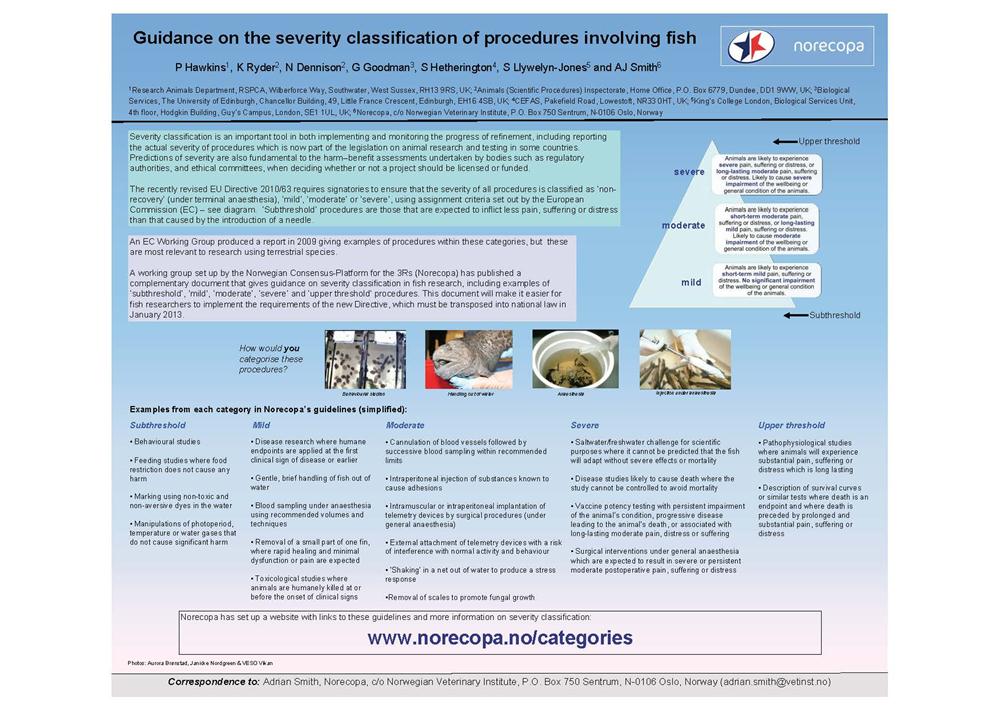Severity Classification
The EU Directive 2010/63 on the protection of animals used for scientific purposes states that all procedures are to be classified into categories according to their severity (Article 15). This webpage lists resources designed to aid this process.
- In July 2009 an expert group commissioned by the EU met to produce guidelines for the severity classification of procedures used on animals in research. Their report is available here. It focuses on procedures that are used on the traditional laboratory animals (see the separate section below for complementary guidelines for fish).
- In 2018 the EU has published a comprehensive guidance document entitled Severity Assessment Framework. Page 20 and onwards gives examples of conditions within the different severity categories, published in 2013.
- The FELASA/ECLAM/ESLAV Report on the classification and reporting of severity experienced by animals used in scientific procedures (Smith et al., 2018) aims to deliver guidance on the assignment of severity, both prospectively and at the end of a procedure. The rationale behind this report is based upon the fact that the examples of severity classification given in Annex VIII of the EU Directive are limited in number and often relate to the procedure rather than assessing its outcome.
- A Working Group convened by AALAS and FELASA has published two papers on a related topic: Harm-Benefit Assessment (HBA). These and other resources on HBA can be accessed here.
- Zintzsch et al. (2017): Guidelines on severity assessment and classification of genetically altered mice and rat lines
- UK Home Office advisory notes on recording and reporting the actual severity reporting of regulated procedures
- UK Home Office advice on severity assessment of genetically altered animals
- Tappe-Theodor et al. (2022): The “WWHow” Concept for Prospective Categorization of Post-operative Severity Assessment in Mice and Rats
- The RSPCA has constructed a comprehensive website entitled Focus on Severe Suffering, in collaboration with LASA, LAVA and IAT, with ideas on how to reduce or avoid severe suffering. The website is designed to help all those involved with research animal use, care or regulation, but on some topics information is tailored for researchers, animal technologists or veterinarians, and members of ethics or animal care and use committees. Statistics on severe suffering in the EU for 2021 and 2022 (published in August 2024).
- CCAC Guidelines on Identification of scientific endpoints, humane intervention points and cumulative endpoints
- More links to resources on severity assessment
- Norecopa har produced a collection of literature on welfare assessment in animals using Grimace Scales.
- See also the PREPARE guidelines for planning animal experiments.
An overview of published systems for severity classification
Norecopa has constructed an overview of systems currently in use in Europe for severity classification of techniques and procedures. The overview will aid identification of areas where more research is needed, and will stimulate discussion so that additional information is submitted. This will hopefully lead to the refinement of the criteria used for severity classification. This work is the result of a collaboration between Anne Zintzsch (ICAR3R, Giessen), to whom comments should be sent; Jan-Bas Prins (Leiden University Medical Centre and the Francis Crick Institute); Nicolaos Kostomitsopoulos (Centre of Clinical, Experimental Surgery and Translational Research, Biomedical Research Foundation of the Academy of Athens); and Adrian Smith (Norecopa).
Severity classification in fish experiments
In September 2009, Norecopa arranged an international consensus meeting entitled Harmonisation of the Care and Use of Fish in Research. A consensus document was issued after this meeting, where the participants concluded, among other things, that a working party should be appointed to produce a report on the severity of procedures used in fish research, complementary to the EU guidelines for the severity classification of procedures.
The working group finished its report in December 2010. It was published under Open Access thanks to sponsorship from Laboratory Animals Ltd.:
Hawkins et al. (2011): Guidance on the severity classification of scientific procedures involving fish: report of a Working Group appointed by the Norwegian Consensus-Platform for the Replacement, Reduction and Refinement of animal experiments (Norecopa). Laboratory Animals, 45:219-224. doi: 10.1258/la.2011.010181

A poster describing the severity classification of procedures involving fish was presented at the 8th World Congress on Alternatives and Animal Use in the Life Sciences, held in Montreal 21-25 August 2011.
The poster may be downloaded here, with permission from the organisers.
The experience of recent years shows that severity classification is still insufficiently harmonised within the EU. Even among experts, animal procedures are often evaluated very differently. Consistent severity assessment and classification of procedures are essential for the ethical review process, and an indispensable part of planning, refining and evaluating animal experiments. Annual statistics of animals used in scientific research are intended to inform the public about the harms inflicted. Severity classification plays a crucial role in this process, and increased harmonisation should be sought.
Other resources:
- Classification and reporting of severity of procedures - a Workshop organised by the University of Bergen, 3 October 2019
- Establishing score sheets and defining endpoints in fish experiments - a Workshop organised by the University of Bergen, 28 January 2020
- A lecture on severity classification, held by Norecopa's secretary at the annual Scand-LAS meeting in 2012, can be downloaded here.
- Running in the wheel: Defining individual severity levels in mice (Häger et al., 2018)
- Conceptual and methodological issues relating to pain assessment in mammals: The development and utilisation of pain facial expression scales (McLennan et al., 2019)
- A sensitive scoring system for the longitudinal clinical evaluation and prediction of lethal disease outcomes in newborn mice (Fehlhaber B et al., 2019)
Thanks for your feedback! Please note that we cannot reply to you unless you send us an email.
What are you looking for?
We value your feedback so we can improve the information on the page. Please add your email address if you would like a reply. Thank you in advance for your help.!
Please contact us by email if you have any questions.
